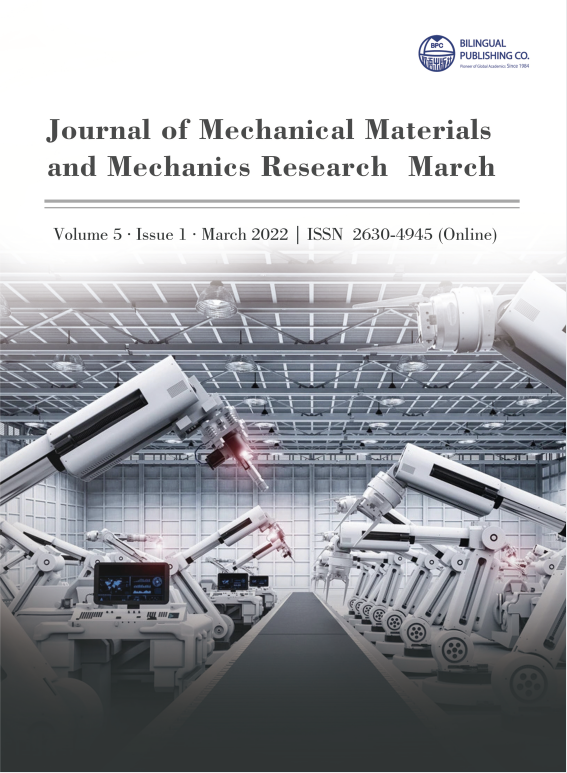-
193
-
105
-
81
-
78
-
72
Vacuum Filling Simulation with Combined Lagranian and VOF Method
DOI:
https://doi.org/10.30564/jmmmr.v5i1.4511Abstract
Jetting succeeded by accumulation is the characteristic of the vacuum filling, which is different from the conventional pressure-driven flow. In order to simulate this kind of flow, a three-dimensional theoretical model in terms of incompressible and viscous flow is established, and an iterative method combined with finite element method (FEM) is proposed to solve the flow problem. The Lagranian-VOF method is constructed to trace the jetting and accumulated flow fronts. Based on the proposed model and algorithm, a simulation program is developed to predict the velocity, pressure, temperature, and advancement progress. To validate the model and algorithm, a visual experimental equipment for vacuum filling is designed and construted. The vacuum filling experiments with different viscous materials and negative pressures were conducted and compared the corresponding simulations. The results show the flow front shape closely depends on the fluid viscosity and less relates to the vacuum pressure.
Keywords:
Vacuum; Finite element method; Lagranian technique; VOF method; Flow frontReferences
[1] Rodríguez-González, P., Robles Valero, P.E., Fernández-Abia, A.I., et al. (2020). Application of vacuum techniques in shell moulds produced by additive manufacturing. Metals. 10(8), 1-20. DOI: https://doi.org/10.3390/met10081090
[2] Sorgato, M., Babenko, M., Lucchetta, G., et al., 2017. Investigation of the influence of vacuum venting on mould surface temperature in micro injection moulding. International Journal of Advanced Manufacturing Technology. 88(1-4), 547-555. DOI: https://doi.org/10.1007/s00170-016-8789-8
[3] Xiao, L., Huang, J., Dai, Y.C., et al., 2010. Rapid fabrication of micro-gear via vacuum casting technique of silicone rubber mould. Advanced Materials Research. 97-101, 4016-4019. www.scientific.net/ AMR.97-101.4016” TARGET=”_blank”> DOI: https://doi.org/10.4028/www.scientific.net/AMR.97-101.4016
[4] Kuo, C., Liu, H., Chang, C., 2020. Optimization of vacuum casting process parameters to enhance tensile strength of components using design of experiments approach. International Journal of Advanced Manufacturing Technology. 106(9-10), 3775-3785. DOI: https://doi.org/10.1007/s00170-019-04905-6
[5] Song, Y.S., Youn, J.R., 2009. Numerical investigation on flow through porous media in the post-infusion process. Polymer Composites. 30(8), 1125-1131. DOI: https://doi.org/10.1002/pc.20668
[6] Robinson, M.J., Kosmatka, J.B., 2014. Analysis of the post-filling phase of the vacuum-assisted resin transfer molding process. Journal of Composite Materials. 48(13), 1547-1559. DOI: https://doi.org/10.1177/0021998313488150
[7] Yang, B., Jin, T., Bi, F., et al., 2014. Modeling the resin flow and numerical simulation of the filling stage for vacuum-assisted resin infusion process. Journal of Reinforced Plastics and Composites. 33(21), 1976-1992. DOI: https://doi.org/10.1177/0731684414551039
[8] Cai, Y.Q., Chen, Q.L., Zhu, Z.Y., et al., 2018. Study on VARI Process Parameters of Fiber Composites. China Plastics Industry. 46(07), 46-50. (in Chinese).
[9] Shen, C.Y., Ren, M.K., Liu, C.T., et al., 2020. A review on the theories and numerical methods for injection molding simulations. Scientia Sinica Technologica. 50(06), 667-692. (in Chinese).
[10] Choi, D., Lee, S., Im, Y., 2005. Fringe element reconstruction for front tracking for three-dimensional incompressible flow analysis. International Journal for Numerical Methods in Fluids. 48(6), 631-648. DOI: https://doi.org/10.1002/fld.943
[11] Hirt, C.W., Nichols, B.D., 1981. Volume of fluid (VOF) method for the dynamics of free boundaries. Journal of Computational Physics. 39(1), 201-225. DOI: https://doi.org/10.1016/0021-9991(81)90145-5
[12] Arai, E., Villafranco, D., Grace, S., et al., 2020. Simulating bubble dynamics in a buoyant system. International Journal for Numerical Methods in Fluids. 92(3), 169-188. DOI: https://doi.org/10.1002/fld.4778
[13] Soh, G.Y., Yeoh, G.H., Timchenko, V., 2016. Improved volume-of-fluid (VOF) model for predictions of velocity fields and droplet lengths in microchannels. Flow Measurement and Instrumentation. 51, 105-115. DOI: https://doi.org/10.1016/j.flowmeasinst.2016.09.004
[14] Roenby, J., Bredmose, H., Jasak, H., 2016. A compu-tational method for sharp interface advection. Royal Society Open Science. 3(11), 160405-160405. DOI: https://doi.org/10.1098/rsos.160405
[15] Li, F., Zhao, H., Ren, F., et al., 2020. Simulations and experiments of mould filling in lost foam casting. International Journal of Cast Metals Research. 33(4-5), 194-200. DOI: https://doi.org/10.1080/13640461.2020.1822572
[16] Fan, W., Anglart, H., 2020. varRhoTurbVOF: A new set of volume of fluid solvers for turbulent isothermal multiphase flows in OpenFOAM. Computer Physics Communications. 247, 106876. DOI: https://doi.org/10.1016/j.cpc.2019.106876
[17] Osher, S., Sethian, J.A., 1988. Fronts propagating with curvature-dependent speed: Algorithms based on hamilton-jacobi formulations. Journal of Computational Physics. 79(1), 12-49. DOI: https://doi.org/10.1016/0021-9991(88)90002-2
[18] Ngo, L.C., Choi, H.G., 2016. A local level set method based on a finite element method for unstructured meshes. Journal of Mechanical Science and Technology. 30(12), 5539-5545. DOI: https://doi.org/10.1007/s12206-016-1122-5
[19] Ngo, L.C., Choi, H.G., 2017. Efficient direct re-initialization approach of a level set method for unstructured meshes. Computers & Fluids. 154, 167-183. DOI: https://doi.org/10.1016/j.compfluid.2017.06.002
[20] Sussman, M., 1994. A level set approach for computing solutions to incompressible two-phase flow. Journal of Computational Physics. 114(1), 146-159. DOI: https://doi.org/10.1006/jcph.1994.1155
[21] Dai, X., Zhang, C., Zhang, Y., et al., 2017;2018. Topology optimization of steady navier-stokes flow via a piecewise constant level set method. Structural and Multidisciplinary Optimization. 57(6), 2193-2203. DOI: https://doi.org/10.1007/s00158-017-1850-x
[22] Sodeyama, K., Yoshino, H., Ohta, M., et al., 2020. Application of a level-set method for deposition of fine particles on a filter. Kagaku Kōgaku Ronbunshū. 46(3), 49-56. DOI: https://doi.org/10.1252/kakoronbunshu.46.49
[23] Hong, X., Xiao, G., Zhang, Y., et al., 2021;2022. A new path planning strategy based on level set function for layered fabrication processes. International Journal of Advanced Manufacturing Technology. 119(1-2), 517-529. DOI: https://doi.org/10.1007/s00170-021-08239-0
Downloads
How to Cite
Issue
Article Type
License
Copyright © 2022 Yujia Chen, Maoxuan Cai, Shixun Zhang, Na Zhang, Wei Cao

This is an open access article under the Creative Commons Attribution-NonCommercial 4.0 International (CC BY-NC 4.0) License.




 Yujia Chen
Yujia Chen





